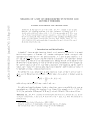Montel's theorem
The set of Montel ( by Paul Montel ) is a set of function theory. It deals with the question of when a sequence of functions holomorphic functions has a compact convergent subsequence. In this sense it is equivalent to the theorem of Bolzano - Weierstrass type sequences. He was found by Paul Montel in 1916.
- Lemma 2.1
- 2.2 Proof ( lemma)
- 2.3 Proof ( set of Montel )
Statement of the theorem
Basic for the formulation is the concept introduced by Montel normal family: a family of holomorphic functions is called normal if every sequence has a compact convergent subsequence. This convergence is considered with respect to the spherical metric, in particular convergence is against approved.
Small set of Montel
A locally uniformly bounded family of holomorphic functions is normal.
Great set of Montel
Let be a family of holomorphic functions in an area and are. For all and applies. Then is normal.
The small set of Montel follows immediately from the great. A comparatively simple proof of the large set can be found in an article by Lawrence Zalcman
Proof of the small set of Montel
For the proof of the small set of Montel you first need the following lemma:
Lemma
Is a holomorphic in a field and locally uniformly bounded sequence of functions. The amount lying in close.
Then is compact convergent.
Proof ( Lemma )
We want to show:
Wherein the open disc designated by the center and radius.
Since the sequence of functions is locally uniformly bounded, the following applies:
Choose.
Be now. Then ( Cauchy integral formula ) applies:
Now it is estimated the integral by the length of the curve and the maximum of the integrand from (actually an estimate of the maximum):
So the following applies:
Now P is dense in G. We can therefore for any given ε choose a finite number of P, so that ε environments overlap completely. ( Since is compact, finally reach many. ) Here we choose our ε precisely so that we get exactly in combination with the upper estimate.
Is the closest to z. Then one can estimate by the upper two estimates the first and last summands respectively. Because yes converge to the pointwise, and the middle term is ( for sufficiently large n) is less than.
Thus we get:
Proof ( set of Montel )
To use the above lemma, we first choose a countable dense subset of the area. (e.g.: only those with rational real and imaginary parts )
Now let us consider the sequence of the site. Since the sequence is locally uniformly bounded, it follows by the theorem of Bolzano - Weierstrass that there is a subsequence such that converges. We denote this sequence.
Now you can look at this sequence of functions in point. The same argument as above, is obtained, there is a convergence point in the partial sequence.
Thus, we define inductively the function consequences.
Now we consider the diagonal sequence. This converges for all after Cantor'schem diagonal sequence method and is therefore compact convergent according to the lemma in the field.










